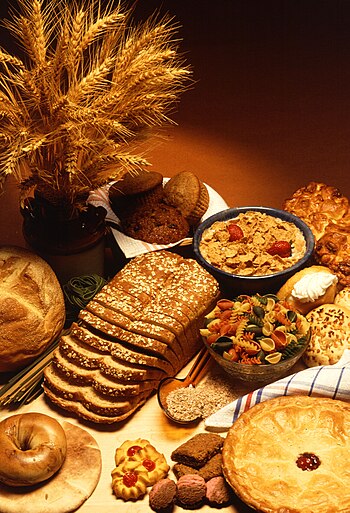 |
| A variety of foods made from wheat. (Photo credit: Wikipedia) |
 |
| PORTSMOUTH, Va. (Aug. 11, 2010) Lt. j.g. Christina Bologna shows a diabetic patient at Naval Medical Center Portsmouth (NMCP) the proper way to read food labels to help monitor her blood-sugar levels. The girl is visiting NMCP for the annual Diabetes Marathon, a day to update diabetic children's school health plan and to refresh the participants' knowledge of the ongoing care needed to manage the disease. (U.S. Navy photo by Mass Communications Specialist 2nd Class Riza Caparros/Released) (Photo credit: Wikipedia) |
A diabetes diet, medically referred to as medical nutrition therapy for diabetes, translates into eating a variety of nutritious foods in moderate quantities and sticking to regular meal times. Rather than a restrictive diet, a medical nutrition therapy is a healthy eating plan that is naturally rich in nutrients and low in calories and fats, with emphasis on vegetables, fruits and whole grains.
Details of the diet
With the help of a dietitian, you can put together a diet based on your tastes, health goals and lifestyle, with valuable information on how you can change your eating habits. A diabetes diet should contain the following recommended foods.
- Healthy carbohydrates: Simple carbohydrates and complex carbohydrates (starches) are broken down into glucose during digestion. It is very important that you focus your diabetes diet on healthy carbohydrates such as vegetables, whole grains, fruits, legumes (lentils, beans and peas) and low fat dairy products.
- Healthy fats: Focus your diabetes diet on foods containing polyunsaturated and monounsaturated fats such as almonds, avocados, olive, canola, peanut oils and walnuts. Even though these fats can help lower cholesterol levels, it is important to eat them sparingly.
- Fiber-rich foods: Fiber is very essential as it helps in controlling blood sugar and decreasing heart disease risks. Vegetables, fruits, legumes, and whole wheat flour are all fiber-rich foods.
- Healthy fish: Fish is one of the best alternatives to high fat meats, and is highly recommended by nutritionists. Cod, tuna, and halibut all have less saturated fats and cholesterol compared to poultry meat.
Additionally, salmon, tuna, mackerel, bluefish and sardines are rich in Omega-3 fatty-acids which are very effective in promoting heart health by lowering triglycerides. It is however important to avoid fried fish and fish high in mercury such as swordfish, tilefish and king mackerel.
Creating the diabetes diet plan
There are several ways to creating a diabetes diet that keeps your sugar levels within the normal range. With the help of a dietitian, you may find a combination of different methods working for you.
- Counting carbohydrates: Since carbohydrates are broken down into glucose, they have a huge impact on blood glucose levels. It is therefore important that you ensure the amount of carbohydrates are the same in your diets, especially if you are on medication.
- Exchange system: It is highly recommended that you adopt an exchange system that groups foods into categories including carbohydrates, meat substitutes, fats and meats.
- Glycemic Index: The glycemic index is used by many diabetic people to select foods, particularly carbohydrates. Those foods with high glycemic index are associated with increase in blood sugar levels than those with low glycemic index. Bread, cereals and whole grain rice among other complex carbohydrates that are high in fiber, have low glycemic indices than simple carbs such as white rice and bread.
Article Source: http://EzineArticles.com/?expert=Lee_Ways Details of the diet
With the help of a dietitian, you can put together a diet based on your tastes, health goals and lifestyle, with valuable information on how you can change your eating habits. A diabetes diet should contain the following recommended foods.
- Healthy carbohydrates: Simple carbohydrates and complex carbohydrates (starches) are broken down into glucose during digestion. It is very important that you focus your diabetes diet on healthy carbohydrates such as vegetables, whole grains, fruits, legumes (lentils, beans and peas) and low fat dairy products.
- Healthy fats: Focus your diabetes diet on foods containing polyunsaturated and monounsaturated fats such as almonds, avocados, olive, canola, peanut oils and walnuts. Even though these fats can help lower cholesterol levels, it is important to eat them sparingly.
- Fiber-rich foods: Fiber is very essential as it helps in controlling blood sugar and decreasing heart disease risks. Vegetables, fruits, legumes, and whole wheat flour are all fiber-rich foods.
- Healthy fish: Fish is one of the best alternatives to high fat meats, and is highly recommended by nutritionists. Cod, tuna, and halibut all have less saturated fats and cholesterol compared to poultry meat.
Additionally, salmon, tuna, mackerel, bluefish and sardines are rich in Omega-3 fatty-acids which are very effective in promoting heart health by lowering triglycerides. It is however important to avoid fried fish and fish high in mercury such as swordfish, tilefish and king mackerel.
Creating the diabetes diet plan
There are several ways to creating a diabetes diet that keeps your sugar levels within the normal range. With the help of a dietitian, you may find a combination of different methods working for you.
- Counting carbohydrates: Since carbohydrates are broken down into glucose, they have a huge impact on blood glucose levels. It is therefore important that you ensure the amount of carbohydrates are the same in your diets, especially if you are on medication.
- Exchange system: It is highly recommended that you adopt an exchange system that groups foods into categories including carbohydrates, meat substitutes, fats and meats.
- Glycemic Index: The glycemic index is used by many diabetic people to select foods, particularly carbohydrates. Those foods with high glycemic index are associated with increase in blood sugar levels than those with low glycemic index. Bread, cereals and whole grain rice among other complex carbohydrates that are high in fiber, have low glycemic indices than simple carbs such as white rice and bread.

No comments:
Post a Comment